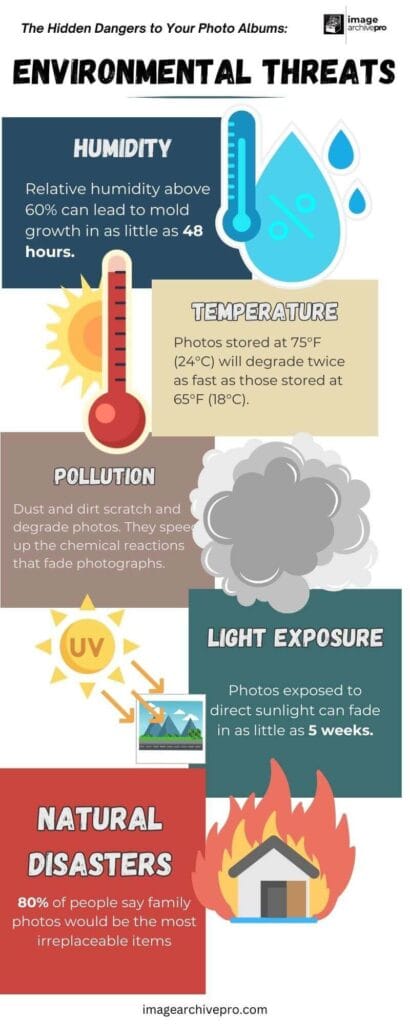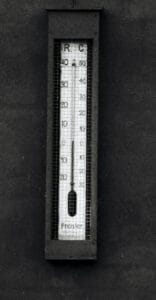
Introduction
Remember that treasured family photo from your childhood? The one where everyone’s smiling, frozen in a moment of pure joy? Now, imagine pulling it out years later only to find it faded, discolored, or worse – damaged beyond recognition.
This scenario is all too real for many individuals with large collections of print photos.
With smartphones capable of storing thousands of pictures, many people have forgotten how meaningful it is to hold a physical picture. Many have also forgotten how vulnerable physical photos are.
The combination of environmental factors along with time are silently destroying these physical photos. Slowly but surely, they are degrading the quality, clarity, and lifespan of your photo collection.
By the end of this article, you will have the knowledge and tools to protect your printed photographs from destructive environmental factors.

Invisible Threats:
How Time and Environmental Factors Harm Your Photos
Time is relentless to everything that exists under the sun. It shouldn’t be surprising that photographs printed on paper are not immune to time’s effects.
Chemical reactions within the photo paper and ink are responsible for the picture itself. Those same chemical reactions just don’t stop once you file your photo away in a shoebox. They continue happening, leading to gradual fading and shifts in color.
That once vibrant sunset might now appear as a washed-out sky. That wedding photo everyone said you looked perfect in? Now you get asked why you took a picture of a catcher’s mitt.
Here’s another punch below the belt: time isn’t working alone. Environmental factors are providing a similar assault on your memories.
Examples of Environmental Factors

1. Humidity:
Humidity, or excessive moisture in the air, poses a real danger to photo preservation. Super high levels can cause photos to stick together. This can cause tearing when separated, as well as setting the stage for mold growth.
Regardless, any moist environment will speed up the degrading process. The quality and lifespan of your collection is at risk. This is why it is never recommended to store your photos in an attic or basement.

2. Light Exposure
UV rays are not friendly to your photographs. The sun can cause quick damage to both the image and the paper it’s on.
Excessive, direct light exposure can really do some damage. Think of how brightly colored outdoor furniture fades over time. The way the sunlight fades outdoor furniture can also bleach the dyes in your photos.
It’s why we highly recommend solutions to shield your photos from harmful light in order to keep them looking great for longer.

3. Temperature Fluctuations
Extreme heat can cause photos to curl or crack, the same way it affects all types of paper.
Additionally, extremely cold temperatures can make photographs brittle and prone to breaking. Even minor temperature changes can lead to condensation forming, which can cause photos to stick together or develop water damage.

4. Air Pollution
Dust particles and other particles in the air can settle on your photos, potentially causing scratches or chemical reactions. Over time, these will damage the structure of the photo as well as affect the overall quality.
It’s a sobering thought that even the air around us can pose a threat.
Recognizing the Warning Signs:
Are Your Albums in Danger?
Now that we understand the threats of the environmental factors at play, how can we tell if our photos are at risk? There are several signs that your photos might be in jeopardy.
Take a close look at the colors
Are they starting to look faded or washed out? This is often one of the earliest signs of photo degradation. Pay particular attention to reds and blues, as these colors tend to fade more quickly than others.
Check for any yellowing or discoloration of the photo paper
This is usually a sign of chemical breakdown occurring in the paper, which can suggest that the photo is deteriorating and losing its original quality over time.
Examine the edges and corners
Are they curling, cracking, or becoming brittle? These physical changes are often signs of environmental damage, particularly from fluctuations in temperature and humidity.
Look for any spots, stains, or mold growth
These can be indicators of moisture damage or chemical reactions occurring within the photo paper.
Pay attention to any photos that seem to be sticking together
If your photos have a tacky feel to them, this could be a sign of high humidity or improper storage conditions.
Questions?
Let’s chat about your photos.
I’d be happy to take a look! Contact Image Archive Pro today and schedule a free consultation.
Best Practices for Photo Preservation
Now that we’ve identified the threats and warning signs, let’s explore how to protect your images from further damage. Proper storage and handling are key to preserving your photos for years to come.
Invest in quality storage materials
Acid-free, archival-quality photo albums or storage boxes are your best defense against environmental damage.
These materials are designed to protect your photos from harmful chemicals and pollutants that can accelerate deterioration.
Check out Archival Methods for amazing, museum quality storage supplies.
Handle photos with clean, dry hands
Did you wash your hands for 20 seconds? Now they’re wet! Get away from the photos!
While you should always use clean, dry hands when handling your photos, it’s much safer to use white cotton or nitrite gloves. Using gloves prevents oils and dirt from your hands from transferring to the photo surface.
Check for signs of damage regularly.
Early detection can prevent minor issues from becoming major problems. Use a soft brush or compressed air to gently remove any dust or debris from your photos, being careful not to scratch the surface.
Choose storage location wisely
Avoid areas with high humidity or temperature fluctuations. Basements and attics, while convenient, are often the worst places to store photos due to their unstable environments. Instead, opt for a cool, dry place away from direct sunlight.
Bringing your images back to life: Photo restoration Options
Despite our best efforts, some photos may have already suffered considerable damage. But don’t despair – photo restoration can often breathe new life into even severely damaged images.
Small tears and creases
If there are tears or rips in the photograph, you can use a clear adhesive tape to carefully repair them from the backside of the photograph. Be sure to use only archival-quality tape that is acid-free and will not yellow over time.
Minor damage
Use a soft, clean cloth to gently wipe away any dust or dirt on the surface of the photograph. This can help improve the overall appearance of the photograph and make it easier to identify any minor damage.
If there are small scratches or scuff marks on the surface of the photograph, you can use a photo restoration pen or marker specifically designed for repairing photographs. These pens contain special inks that match the color of photographs and can effectively cover up minor damage.
Extensive damage
In cases where there is significant damage or missing sections of the photograph, it may be best to seek professional restoration services. Many photography studios offer photo restoration services that can repair even severely damaged photos.
Preserving the Past for the Future
Time and environmental factors pose significant threats to our photograph collection. Beyond ink and paper, the very memory the photos represent are threatened. However, with knowledge and the right tools, we can take steps to protect these irreplaceable snapshots.
Prevent future damage by storing your photographs in archival-quality albums or boxes made specifically for preserving photos. Avoid exposing them to direct sunlight or extreme temperatures to prevent fading and deterioration.
Lastly, make digital copies of your old photographs as an extra precaution in case they are ever lost or damaged beyond repair. You can scan them onto your computer or use a photo scanning service for high-quality digital copies that will last for years to come.
Act today. Inspect your photo collection, invest in proper storage materials, and consider creating digital backups.
